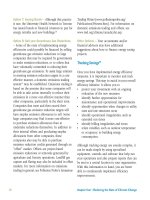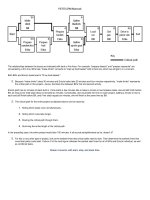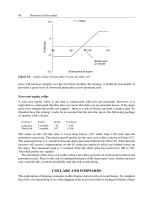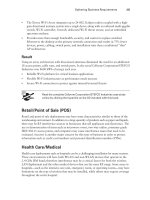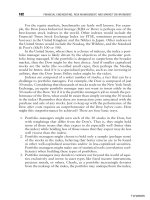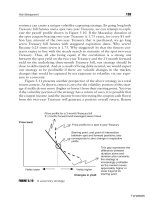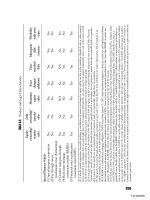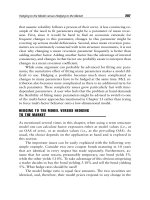Study guide for come into my trading room phần 7 pptx
Bạn đang xem bản rút gọn của tài liệu. Xem và tải ngay bản đầy đủ của tài liệu tại đây (74.97 KB, 21 trang )
Rating Yourself
Below 21 Poor. With grades like this, you should steer clear of day-
trading. If you are intent on day-trading, please return to the recom-
mended materials and study them carefully before retaking this test.
21–24 Fairly good. You understand the key concepts of day-trading. Do
yourself a favor, and review the questions that you missed. This topic
is too important to leave out a few blanks!
25–28 Excellent. You have a good grasp of the essential concepts. Just
keep in mind that the Advanced Concepts, described in the next
chapter, also can be applied to day-trading.
Required Reading
Elder, Alexander. Come into My Trading Room (New York: John Wiley
& Sons, 2002). See “Day-Trading” in Chapter 6 (pages 134–153).
Additional Materials
Appel, Gerald. Day-Trading with Gerald Appel (video) (New York:
Financial Trading, Inc., 1989).
118 ANSWERS AND RATING SCALES
SEVEN
ADVANCED CONCEPTS
Answer 54
1. E
2. B
3. D
4. F
5. A
6. C
Give yourself a point for each correct answer.
The slope of the EMA reflects the direction of market inertia, whereas
the slope of MACD-Histogram shows the direction of market momen-
tum. Combining the messages of these two indicators is the key prin-
ciple of the Impulse System. The longer you wait to recognize a splash
of momentum, the lower the profitability. Taking profits and jumping
out of successful trades is the hardest psychological factor of momen-
tum trading.
Answer 55
1. D, F
2. A, B, C, E, G, H
119
Give yourself a point for each correctly identified cluster. Add two points
if you got the bonus question right, or a point for getting it partly right.
Buy signals emerge when both the EMA and MACD-Histogram are
rising together; sell signals emerge when both are falling. The weekly
uptrend (not shown) gives extra weight to bullish signals. Bearish clus-
ters show reactions against the uptrend, but once those signals cease,
the uptrend embarks on its sharpest upmoves.
At the right edge of the chart—neutral. The trend is getting old, and
MACD-Histogram is weakening. Tighten stops on long positions.
Answer 56
1. E
2. B, C, F, G
3. A
4. C
5. B, D
6. D-G
Give yourself a point for each correct answer (half a point if you missed
one of several occurrences). Add two points if you got the bonus ques-
tion right, or a point for getting it partly right.
The day begins with a string of shorting signals: a downward gap,
followed by a cluster of Impulse sell signals, followed by a downside
breakout from the opening range, and then more Impulse sell signals.
The deepening bottoms of MACD-Histogram call for lower prices
ahead. The best day-trading opportunities tend to present themselves in
the beginning of the session, although the Impulse System continues to
give sell signals throughout the day. At point G prices sink to a new low,
but MACD-Histogram completes a bullish divergence—the last call to
take profits on intraday shorts.
120 ANSWERS AND RATING SCALES
At the right edge of the chart—neutral. The trend is down and prices
are weak and closing near the lows, but there is a bullish divergence.
Tomorrow check the 25-minute chart and be ready to follow the first
cluster of the Impulse System signals.
Answer 57
B. 1 and 2. Give yourself four points for choosing the right answer.
Most people are more objective when they do not have money at
risk. Before he enters a trade, a rational trader estimates his profit as
well as his risk, compares them and makes his go–no go decision. He
tries to select trades in which he stands to win more than he risks—the
higher the ratio, the better. If the exit target is at a channel line, that tar-
get will move with the passage of time, but it is important to have a gen-
eral idea where it is before you enter.
Answer 58
C. 1, 2, and 3. Give yourself four points for choosing the right answer.
One of the few statistically proven market behaviors is the tendency
of prices to fluctuate above and below value. Channels help identify
manic levels for selling longs and going short and depressed levels for
covering shorts and going long. Before putting on a trade, make sure
that the channel is wide enough to be worth trading. A well-drawn
channel contains about 95% of prices, but no channel is perfect. Some
price swings are so strong that they punch out of the channel, whereas
others are too weak to reach it.
ADVANCED CONCEPTS 121
Answer 59
1. A, C, D
2. B, E
Give yourself a point for each correctly identified signal. Add two points
if you got the bonus question right, or a point for getting it partly right.
When prices hit the upper line of a well-drawn channel, they reveal
market mania and give a sell signal. You can place your sell order in
advance, at the channel line. If you are in front of the screen during the
day, you may wait for prices to punch above that line and then exit
when prices fail to make a new high for the day or, as a fallback, when
they weaken and hit the channel wall from above. The time to cover
shorts is when prices hit the lower channel wall. Notice a beautiful buy
signal between points C and D. Prices came back to touch the EMA
before embarking on their most dynamic rally. The only way to have
caught that buy signal was to estimate tomorrow’s EMA value each day
and place a buy order there for the day ahead.
At the right edge of the chart—bullish. The EMA has ticked up, and
prices straddle the EMA, offering a value trade. It is time to buy and be
ready to take profits near the upper channel line.
Answer 60
True 1, 4, 5
False 2, 3
Give yourself a point for each correct answer.
Stops must be defined by both technical analysis and money manage-
ment and placed immediately after entering a trade. Most traders should
place actual stop orders: only the pros of proven discipline may use men-
tal stops. Relying on so-called advanced analysis instead of stops is a sign
of arrogance that has been the undoing of countless traders.
122 ANSWERS AND RATING SCALES
Answer 61
1. B
2. E
3. D
4. C
5. A
6. F
Give yourself a point for each correct answer.
Market noise is the extent by which today’s extreme price extends out-
side yesterday’s extreme—the high in downtrends, the low in uptrends.
Average Penetration is the average level of market noise during the
lookback period. We multiply Average Upside Penetration by the coef-
ficient and add it to the highs to place stops in downtrends, or multiply
Average Downside Penetration by the coefficient and subtract it from
the lows to place stops in uptrends.
Answer 62
D. 1, 2, 3, and 4. Give yourself four points for choosing the right answer.
Margin works great when you’re right, but hits you even harder on
losing trades. It raises the cost of trading, as well as the stress level,
because with margin you trade beyond your means. A small trader who
goes on margin can make more money when he is right, but is almost
certain to underperform a cash trader in the long run.
ADVANCED CONCEPTS 123
Answer 63
1. A
2. C
3. A
4. B
5. B
Give yourself a point for each correct answer.
Trends tend to emerge from sleepy trading ranges in formerly obscure
stocks. The width of a channel matters little if you are positioning your-
self for a major trend. Stocks are likely to swing within the trend, requir-
ing wider stops. Wide channels, active trading, and taking profits at the
channel line are required for swing trading. Anyone who says that trad-
ing, either trends or channels, is easy is either a genius or, more likely,
a beginner.
Answer 64
Item 3 is not a factor. Give yourself four points for choosing the right
answer.
The more time to expiration, the closer the exercise price, the higher
the volatility and the interest rates, and the more expensive an option.
Options are remarkably blind to trends, even though they are highly
attuned to market volatility.
Answer 65
1. B
2. E
3. A
4. C
5. D
124 ANSWERS AND RATING SCALES
Give yourself a point for each correct answer.
Options offer an enormous range of choices, from buying calls out-
right—the beginners’ favorite tactic—all the way up to diagonal butter-
fly spreads and beyond. Sophisticated traders tend to write rather than
buy options.
Answer 66
C. 1, 2, and 3. Give yourself four points for choosing the right answer.
Writing covered options is an expensive proposition because of com-
missions on both stocks and options; naked writing exposes traders to
unlimited risk. For those reasons, money management is the corner-
stone of any intelligent option-writing campaign. Option writers profit
from selling hope—it is better to sell hope that is unlikely to be fulfilled,
writing calls in downtrends and puts in uptrends. Time works for the
writer because the options he sells lose value with each passing day.
There is no reason to wait for the expiration if the option you sold has
lost almost all its value—buy it back, kill the risk, and move on to the
next trade.
Answer 67
1. D
2. E
3. A
4. B
5. C
Give yourself a point for each correct answer.
If you grow wheat and hedge by selling a corresponding quantity of
futures contracts, you eliminate price risk between that time and the har-
vest, when wheat is sold to consumers and futures bought back. Razor-
thin margins in futures lure beginners into overtrading, and they take on
ADVANCED CONCEPTS 125
more risk than they can handle. Faraway months normally sell for more
than nearby ones because of storage and insurance costs; an inverted
market, with more expensive nearby contracts, reflects very high
demand, which is bullish. Industrial producers and consumers can
legally trade futures using inside information. Supply-driven markets
tend to be fast and furious; bad weather can stress the balance between
supply and demand much faster that changing consumer tastes.
Rating Yourself
Below 56 Poor. If you have already learned conventional methods, you
should be able to do better with these advanced techniques. Please
return to the recommended materials, study them, and retake this test
a few days later.
56–66 Fairly good. You are starting to get a handle on new, unconven-
tional methods. It would be a good idea to return to the recom-
mended literature, review answers to the questions you missed, then
return to the Study Guide a few days later.
67–77 Excellent. You are way ahead of the game. Now tighten your seat
belt because you will be moving forward to the topic that separates
the winners from the losers—money management.
Recommended Reading
Elder, Alexander. Come into My Trading Room (New York: John Wiley
& Sons, 2002). See Chapter 5 “Trading.”
Additional Reading
McMillan, Lawrence G. Options as a Strategic Investment
, 3rd ed. (New
York: New York Institute of Finance, 1999).
Teweles, Richard J., and Frank J. Jones. The Futures Game, 3rd ed. (New
York: McGraw-Hill, 1998).
126 ANSWERS AND RATING SCALES
EIGHT
MONEY MANAGEMENT
Answer 68
Choice 5 is correct. Give yourself four points for choosing the right answer.
A system with a positive expectation allows you to make money over
a long series of trades—it gives you an edge but not a guarantee of
success. A system may deliver more losing than winning trades but still
be profitable if winners are bigger than losers. Each individual trade is
dicey, but a well-designed system creates a positive expectation over a
long series of trades. Money management can protect a trader using
such a system, but it cannot turn a losing system into a winner.
Answer 69
1. 533
2. 24
3. 69
4. 18,750
5. 37.5%
Give yourself a point for each correct answer.
Modern society makes it easy to live without counting, but if you
want to succeed in trading you have to think—and count—on your feet.
You may own a calculator, but you must be able at least to estimate the
results of any arithmetic operation in your head.
127
Answer 70
Choice 3 is correct. Give yourself four points for choosing the right answer.
The 2% Rule, the most important rule of money management, protects
you from ever losing more than 2% of your account equity on any sin-
gle trade. If your stop is close and risk per share is small, you may trade
a bigger size, as long as you are mindful of the overnight risk. If the stop
is far and risk per share is high, the size has to be smaller because your
total dollar risk may never exceed 2% of your account equity.
Answer 71
B. 1 and 2. Give yourself four points for choosing the right answer, or
two points if you answered C.
According to the 2% Rule, you may not risk more than 2% of your
account equity on any given trade, including commissions and slip-
page. Having a $50,000 account allows you to risk no more than
$1,000 per trade. Trade 1: you risk $1.50 per share on 500 shares, for a
total of $750, which is acceptable. Trade 2: you risk $3 per share on 300
shares, for a total of $900, which is acceptable. Both trades leave room
for slippage and commissions. Trade 3: you risk $1 per share on 1,000
shares, for a total of $1,000, which leaves no room for slippage or com-
missions. Trade 4: you risk $6 per share on 200 shares, for a total of
$1,200, which would break the 2% limit. Trade 5: you risk $2 per share
on 700 shares, for a total of $1,400, which would break the 2% limit.
Answer 72
A. 1, 3
B. 2, 4, 5
Give yourself a point for each correct answer.
The key rule of money management is never risk more than 2% of
your account on any given trade. The dividing line is drawn at 2%—if
you risk less, it is a businessman’s risk, and if you risk more, you are
128 ANSWERS AND RATING SCALES
staring at a loss. Two percent of $100,000 comes to $2,000, 2% of
$20,000 to only $400—this is your maximum permitted risk per trade.
Trade 1: you risk $1.25 per share on 1,000 shares for a total of $1,250—
less than 2% of a $100,000 account (businessman’s risk). Trade 2: you
risk $2 per share on 300 shares for a total of $600—more than 2% of a
$20,000 account (risk of loss). Trade 3: you risk $1.50 per share on 200
shares for a total of $300—less than 2% of a $20,000 account (busi-
nessman’s risk). Trade 4: you risk $4 per share on 1,000 shares for a total
of $4,000—more than 2% of a $100,000 account (risk of loss). Trades
2 and 4 could still be done, only with a smaller size, pushing the risk
below 2% of each account. In trade 5, without a stop, what if that stock
slides to $5, which could happen in a bear market? Busting through the
2% risk limit can damage even the biggest account.
Answer 73
Yes. Give yourself three points for choosing the right answer.
Bill plans to risk $4 per share on 100 shares, or $400, plus commis-
sions and slippage. The 2% Rule allows him to risk up to $500. His
trade is within the limits of the 2% Rule. Still, he is pushing it a bit. As
a beginner, he’d better stay farther away from the 2% limit. Perhaps he
could focus on lower-priced stocks and work on his analysis, entry, and
exit techniques without coming so close to the 2% limit.
Answer 74
Yes. Give yourself three points for choosing the right answer.
Since a gold futures contract has 100 ounces, a trader wins or loses
$100 whenever gold rises or falls $1 per ounce. Gary plans to risk $300,
plus commission and slippage. The 2% Rule allows him to risk a maxi-
mum of $400. The 2% Rule allows him to take that trade. Gary is aim-
ing for a $900 profit, risking $300. Those are good odds, but his plan
illustrates how hard it is to trade a small account. A mere $3 move
against him puts him near the limit of his risk tolerance. He may want
to look into trading smaller minicontracts.
MONEY MANAGEMENT 129
Answer 75
No. Give yourself three points for choosing the right answer.
The 2% Rule limits Susan’s maximum allowed risk to $1,000. Risking
$2.50 per share on 500 shares would expose $1,250 to risk, plus com-
missions and slippage. This trade would violate the 2% Rule. Susan has
to reduce the number of shares she’ll buy. If a proven system gives her
this trade, she should take it, but on a smaller scale—300 shares rather
than 500.
Answer 76
Choice 3 is correct. Give yourself four points for choosing the right answer.
All of the choices given are helpful, but none compares in impor-
tance with having a boss whose main tasks are money management and
discipline. People who trade well for institutions can rarely match their
performance level once they leave to trade for themselves, because they
leave the manager behind. A private trader has to be his own manager,
which is why it is essential to write down your trading plans and rate
yourself on your adherence to them.
Answer 77
Choice 2 is correct. Give yourself four points for choosing the right answer.
Record your account size at the beginning of the month. To observe the
6% Rule, you must stop trading as soon as your equity dips 6% below that
level. Stay out for the balance of the month. Your risk is at its highest when
you put on a trade; the total account risk will never exceed 6% because
then you simply may not put on another trade. Following the 2% Rule, you
may have more than three open positions, if each risks less than 2%.
Answer 78
Yes. Give yourself four points for choosing the right answer.
130 ANSWERS AND RATING SCALES
Six precent of a $90,000 account comes to $5,400—this is Ann’s per-
mitted risk of loss for the month. She already lost a total of $2,400 on trades
A and B, but trades C and D are moving in her favor, stops are at breakeven,
and she has no money at risk in them. This leaves her with $3,000 of per-
mitted risk capital. Trade E would expose $1,500 to risk—this is less than
2% of her account, while her total risk for the month remains below 6%.
Answer 79
No. Give yourself four points for choosing the right answer.
Six percent of a $150,000 account comes to $9,000—this is Peter’s
permitted risk of loss for the month. No matter how profitable early in
the month, he has already lost $5,000 of his starting equity and has two
open trades, risking $1,900 and $1,700, for a total of $8,600 either lost
or at risk. There is simply no room for one more trade, unless he wants
to close out one of the trades in which he has money at risk and free up
enough risk capital for a new trade.
Answer 80
Yes. Give yourself four points for choosing the right answer.
Six percent of a $30,000 account comes to $1,800—this is Jim’s per-
mitted risk of loss for the month. So far he lost $500, besides having two
profitable trades. If he trades the same size in D and E and uses similar
stops as in his previous trades, his total risk exposure will be $1,500—
below his monthly limit.
Answer 81
True 1, 3, 5
False 2, 4
Give yourself a point for each correct answer.
The less money you risk on any given trade, the more objective you
are likely to be, and the more likely that trade is to be a winner. It is
important to trade a fairly consistent size and reduce it when losing.
MONEY MANAGEMENT 131
Putting on bigger trades in an attempt to recoup losses is typical ama-
teur behavior. Professionals plan their trades for safety and survival first,
for big profits second. The best trades tend to have very tight stops,
allowing you to trade a large size with a fairly small amount at risk.
Answer 82
Choice 2 is correct. Give yourself four points for choosing the right answer.
Overtrading means risking too much for your account. Making three
trades a day can be a legitimate level of activity for a day-trader, and an
active swing trader may make 10 trades a week when the market is run-
ning. The maximum risk per trade in a $100,000 account is $2,000, and
someone who buys right above support with a very tight stop may be
able to afford to trade a big size. The maximum risk for a $100,000
account is $6,000 per month, allowing five open trades risking $1,000
each. Having 10 open positions, whose risk amounts to $7,500, busts
through the 6% Rule and indicates overtrading.
Rating Yourself
Below 54 Poor. Failing this test gives you plenty of company. Most peo-
ple do not know enough about money management. You must bring
yourself up to speed—this aspect of trading cannot be skipped!
Please return to the recommended materials, study them, and retake
this test a few days later.
54–60 Excellent. You show a level of understanding of trading that few
people possess. If you implement your knowledge in practice, you
should get ahead of the game. Now please move on to the next
essential topics—record keeping and accountability.
Required Reading
Elder, Alexander. Come into My Trading Room (New York: John Wiley & Sons,
2002). See Chapter 7 ”Money Management Formulas.”
Additional Reading
Vince, Ralph. Portfolio Management Formulas (New York: John Wiley & Sons,
1990).
132 ANSWERS AND RATING SCALES
NINE
THE ORGANIZED TRADER
Answer 83
Factor 3 is correct. Give yourself three points for choosing the right
answer.
All factors listed here are important, but none more so than disci-
pline. Markets are full of intelligent people with experience and imagi-
nation who have been trained and still fail to make money. Discipline
is the key factor; without it all others are useless.
Answer 84
Choice 2. Give yourself four points for choosing the right answer.
Good records are the key factor in disciplined trading. Keeping them
leads to a reduction in trading mistakes. No matter how good your
records, no matter how proficient you become in trading, nothing per-
mits you to relax your money management discipline; if anything, as
traders get better, they tend to tighten their money management.
Answer 85
E. All of the above. Give yourself four points for choosing the right
answer.
Entry and exit dates and price levels are the basic starting points for
this spreadsheet. It also helps to keep an eye on expenses. A more
133
sophisticated trader uses his spreadsheet to calculate his performance
grade for every trade, that is, the percentage of a trading channel caught
in that trade. He can also rate the quality of entries and exits—whether
he bought or sold closer to the top or the bottom of the daily bar.
Answer 86
C. 1, 2, and 3. Give yourself four points for choosing the right answer.
If you intend to treat trading as a business, you must know its cash
position at any given time. Equity in a trading account consists of the
current value of all open positions, marking open profits and losses to
market, as well as cash and cash equivalents, such as T-bills. Funds out-
side of your trading account, such as savings or credit lines, are imma-
terial to your equity.
Answer 87
Trader 5 has the best equity curve. Give yourself four points for choos-
ing the right answer.
Trader 4 earned the biggest profit, but his drawdown is outright scary.
A $28,000 drawdown represents more than a quarter of this trader’s
starting equity. What if such a deep drawdown comes at the very
beginning of a money management period? No matter how brilliant a
comeback, this kind of trading is an invitation to disaster. Most fund
managers look for steady gains with small drawdowns. If your draw-
down never goes into double digits, your performance is brilliant.
Answer 88
Choice 4 is correct. Give yourself three points for choosing the right
answer.
One chart per entry or exit may not be enough, because entries and
exits tend to be complex affairs with several parameters. You may want
to print out a weekly, a daily and an intraday chart for an entry and a
134 ANSWERS AND RATING SCALES
daily, and an intraday for an exit. Five charts per entry or exit is too
much; trading decisions are best reduced to a small number of key
parameters.
Answer 89
C. 1, 2, and 3. Give yourself four points for choosing the right answer
(two points if you chose D).
Gloating after taking a profit or cringing after taking a loss does noth-
ing to improve future performance. What did I do right? Have I made a
mistake? What should I do differently next time? A focused, disciplined
trader keeps asking himself these and other questions, and a trading
diary helps him answer them. People who have the discipline to keep
good records have the discipline to win consistently. Still, it may be
impractical for a very active trader to keep a diary of every single trade.
In that case, it is important to keep a diary for every second, third, or
fifth trade, in strict order, rather than deciding to keep it for “interesting”
trades and omitting it for “ordinary” trades. Knowing which is which
tends to come well after a trade has been closed out.
Answer 90
Entry—4. 75%.
Exit— 2. 25%.
Give yourself two points for each correct answer.
The entry grade rates the quality of your entry by expressing it as a
percentage of that day’s range. If the high of the day was 48, the low 44,
and you bought at 47, then your entry grade is 75, meaning you missed
75% of the day’s range. The lower the percentage while buying, the bet-
ter. The exit grade rates the quality of your exit. If the high of the day
was 54, the low 50, and you sold at 51, your exit grade is 25. It means
you captured 25% of that day’s range. The higher the percentage, the
better for the seller. The idea is to get your buying grade below 50% and
THE ORGANIZED TRADER 135
your selling grade above 50%. This is much harder to accomplish than
it looks.
Answer 91
C. 1, 2, and 3. Give yourself four points for choosing the right answer
(two points if you chose B).
Rapidly changing prices affect people like the noise and flashing of
slot machines, tempting them to put in another quarter. Making deci-
sions to buy, sell, or stand aside when the markets are closed offers
traders the luxury of time. Comparing your stock or future to others adds
an extra dimension to your decision-making process. It is a bad idea to
ask for advice on specific trades before taking them—those trades are
yours and the decision is yours alone.
Answer 92
1. A
2. B
3. C
4. E
5. D
Give yourself a point for each correct answer.
Having to describe a chart forces you to focus on specific signals that
led to a trading decision. Live charts often seduce traders into joining
emotional crowds; reading your orders from a printed sheet reinforces
discipline. If you planned to buy a stock if it trades flat, but it gaps up
the next morning and you have not planned for it, there is no reason to
trade. When a stock does something you have not anticipated, that is a
clear signal that your decision making was not in gear with the market,
and putting on a trade is not a good idea.
136 ANSWERS AND RATING SCALES
Answer 93
D. 1, 2, 3, and 4. Give yourself four points for choosing the right
answer.
The trader’s spreadsheet provides a basic record of every trade,
including its performance grade. The equity curve tracks the health of
your account as a whole. The trading diary allows you to learn from
visual records of past trades. The action plan helps you face the next
trading day in a calm and disciplined manner. All of these records are
essential for success; only the ABC rating system is optional. You need it
if you track a large number of stocks and futures, but can do without it if
you watch just a handful.
Answer 94
B. 1 and 2. Give yourself four points for choosing the right answer.
Second-guessing a system, or making trading decisions on the basis
of factors which are not included in the system, dramatically increases
the range of options but reduces the likelihood of success. Second-
guessing raises the level of psychological stress, subverts discipline, and
leads to impulsive trading.
Answer 95
C. 1, 2, and 3. Give yourself four points for choosing the right answer.
Telling people about your open positions is like inviting them to
watch you get intimate with your significant other. It will make you
more popular and invite friendly advice on positions you haven’t con-
sidered, none of which is likely to lead to a successful outcome. You
need to be strong enough to shoulder all the responsibility for a trade;
you may discuss it with others only after closing it.
THE ORGANIZED TRADER 137
Answer 96
E. All of the above. Give yourself four points for choosing the right
answer.
Trading requires time just as much as it requires capital. You need to
review all markets in which you are interested at least once a week,
usually on weekends. All open positions have to be reviewed daily. You
need to keep a timetable of all important news that may impact your
market in order to decide whether to hold your position, reduce its size,
or get out. Breakouts from opening ranges can help with entries; weak
prices near the close can give the signal to get out of a trade. The more
time you put into the markets, the more profit they are likely to return
to you.
Answer 97
1. A
2. E
3. C
4. D
5. B
Give yourself a point for each correct answer.
The ABC rating system helps traders use their time more efficiently.
It calls for a weekly review of all markets you track and sorting them
into three groups. A is the most promising, and usually the smallest,
group, where you anticipate a trade the next day. Stocks or futures in
group A must be reviewed in depth daily. B is the group where you
expect a trade within a few days, and its stocks or futures should be
reviewed a few days later. C is the group where you do not anticipate
a trade for a week, and its stocks or futures can be set aside for the rest
of the week.
138 ANSWERS AND RATING SCALES
